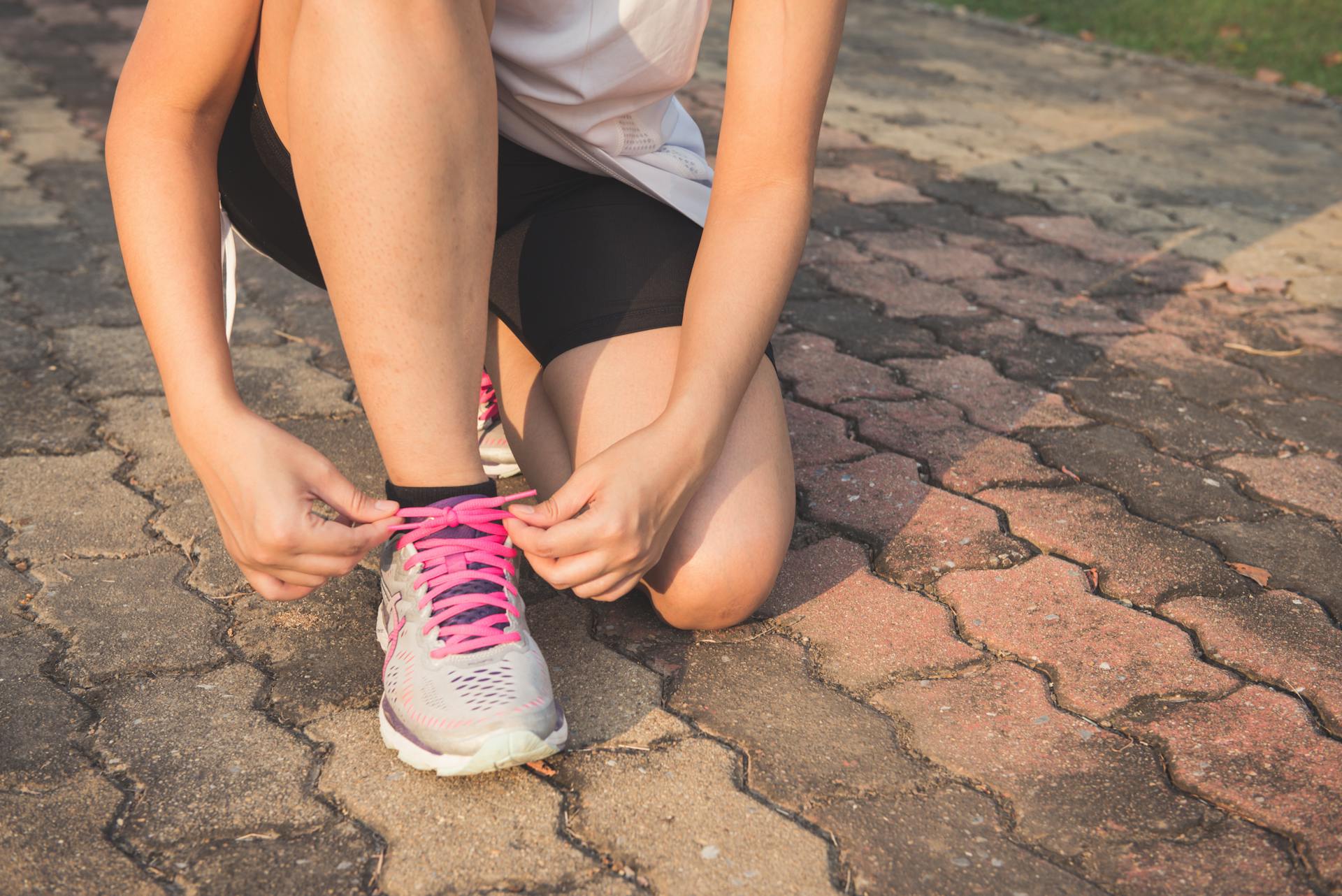
Ankle pain is a common complaint of runners, which can make it difficult to continue with your regular training routine. The causes of ankle pain can vary, but many times it is due to an injury or irritation of the soft tissue, bones, joints or veins in the ankle.
The most common cause of ankle pain after running is a strain or sprain in the ligaments around the ankle joint. This occurs when intense forces stretch the ligaments beyond their capacity creating microscopic tears in the structure. This causes swelling, tenderness and pain over the injured area. Other causes can include an overuse injury such as tendonitis, plantar fasciitis or a stress fracture in one of the bones around your ankle joint. These conditions require rest from irritating activities and sometimes treatment from a healthcare professional to resolve.
In addition to a direct injury or tear in your tissues, running on improper terrain such as unlevel ground, running too much too soon or wearing incorrect shoes can also contribute to ankle pain after running. Incorrect shoes tend to lack cushioning and arch support which may lead to excessive force being applied directly on your bones when your foot hits hard surfaces like concrete or asphalt. Unlevel running surfaces put increased stress on one side of your foot then the other resulting in inflammation and discomfort with normal movement patterns while running. Finally, if you are not used to running long distances it is important to start gradually and build up gradually increasing no more than 10 percent at a time in order to avoid overuse injuries that occur with sudden increases of activity load on specific tissues and joints.
In conclusion, understanding why your ankle hurts after running is important for helping you find an appropriate treatment plan that works best for you including taking time off from high intensity movement until you’re fully healed as well as making sure you pay attention when selecting appropriate shoes for proper support and cushioning when running on harder surfaces.
See what others are reading: What to Wear When Running in Rain?
What can cause ankle pain after running?
Ankle pain after running can be an unnerving experience, but it doesn't have to be. With the right understanding of the issue and some proactive measures, you can prevent or ease any pain.
A major cause of ankle pain after jogging or running is overuse injuries such as tendinitis or bursitis, which occur due to repetitive strain on the muscles and joints. If you're pounding the pavement multiple times a week, try reducing your exercise schedule or substituting gentle alternative exercises such as swimming and biking to give your joints a break. Also, be sure to stretch before and after each run to help prevent muscle fatigue.
Poor footwear is also a huge contributor to ankle pain after running. Shoes that do not provide adequate cushioning and support will lead to discomfort with each step. Worn out soles can lead to greater impact on the ankles when they hit the ground. Make sure you are always wearing shoes in good condition and change them out every 300-500 miles depending on how frequently you run. Investing in footwear with shock absorbent cushioning can also provide much needed support for your ankles while running.
Finally, if you've recently changed up your workout routine, it may be worth having a professional athlete or trainer assess your running form for any possible mistakes that could induce ankle pain during exercise. Even small alterations in form can cause significant damage over time if not addressed quickly, so don't hesitate to ask for help from a professional if needed!
For another approach, see: Ankles Hurt
How can I prevent ankle pain after running?
Ankle pain after running can be an annoying and disabling injury. However, there are ways that you can prevent it from occurring. The most important thing to remember is to take the proper steps before, during and after running.
Before running, you should stretch your ankles and the muscles surrounding them. You should also warm up the muscles surrounding your ankles by performing low-impact exercises like walking and jogging for a few minutes before picking up the pace for running. Completing a 10-minute warm-up routine can help prevent any ankle injuries as well as improve your overall performance while running.
During running, it is also important to pay more attention to where you are stepping and make sure that you’re not landing forcefully on your heels or toes as this could cause pain throughout your body, especially around your ankles. Additionally, make sure that you wear the right shoes that provide adequate supporting cushioning and shock absorption especially when you are running on rough surfaces like trails or uneven roads.
After running, it is strongly recommended to perform ankle-strengthening exercises that focus on balance and stability such as heel raises or even walking on stairs at an inclined level in order to make them stronger so as not having another ankle injury in the future. Additionally, if you feel any ache after or during a run then an ice pack or a massage might help relieve some of the pain before switching back into physical activity again.
By following these tips, you should be able to successfully avoid ankle pain after a run in no time!
Suggestion: How to Train a Husky to Not Run Away?
What kind of treatment can help relieve ankle pain after running?
Ankle pain following running can put a real damper on your ability to exercise and stay active. But, don’t let discomfort keep you from engaging in an activity you enjoy. There are treatments that have been proven to help to alleviate ankle pain while running.
One common approach is rest and ice, which is thought to reduce inflammation and discomfort in the affected area. This method is simple but often effective in relieving pain. Start by stopping any activities that may be causing irritation, such as running or jumping. Follow this up by icing the ankle for 15-20 minutes every two-to-three hours for several days until symptoms diminish.
Stretching can also help reduce ankle pain while running and introduce mobility back into the joint. Doing exercises such as a calf stretch can improve blood circulation to the affected area and restore flexibility over a period of time. Even incorporating a few simple dynamic stretches before going for a run can create lessened stress on the joint afterwards, reducing inflammation and helping with mobility.
Massage therapy is another option for relieving soreness after running or any kind of physical activity including sports or dancing. Massage has been known to significantly decrease both acute and chronic swelling associated with damaged ligaments surrounding the foot, reducing stiffness in the ankle over time. Lastly, wearing proper shoe gear helps considerably reduce injury risk connected with overuse of the lower body muscles and joints by providing stability and cushioning as one runs.
Suggestion: Tennis Ball Relieve Back Pain
What are the most common causes of ankle pain after running?
Ankle pain after running is a common problem for athletes, as well as casual joggers, and can be caused by a variety of circumstances. While some ankle pain is not serious and may subside after a few days, in certain cases it can be indicative of a more serious injury. Let’s take a look at some of the most common causes of ankle pain following a good run.
Improper Form: When running, it is important to adopt an upright posture and land with the foot in line with the knee and hip joints – landing on the heel creates more discomfort in the ankles because the impact is concentrated there. Ankles are expected to absorb impact whenever you run, and if they are not used to doing so they may hurt afterward.
Weak Muscles: Weak muscles around the ankles may lead to instability during your run, which could reduce your running speed or cause pain later on. Muscles that are weak yet tight hold your body in different positions, which when maintained for extended duration while running will eventually cause discomfort in your ankles.
Overexertion: Ankles can bear tremendous forces associated with running particularly if you don’t give yourself enough rest in between runs or do intensive training too often. Overexertion can overload your muscles and other soft tissues around the joints thus causing discomfort later.
Inappropriate Shoes: It is important to wear shoes designed for running that provide cushioning for shock absorption, which helps minimize ankle pain during and after running sessions. Wearing tennis shoes or flat soled shoes (e.g., Converse) for any type of exercise puts extra strain on ankles due to their decreased pressure-absorbing capabilities.
Ankle pain after running can be debilitating but understanding how it occurs can help you prevent future issues before they become serious injuries or ailments. Luckily there are simple solutions such as ensuring adequate rest periods between runs, wearing proper footwear tailored to shock absorption and maintaining appropriate form while exercising that all help mitigate chances of injury or discomfort caused by impairment associated with our beloved sport – running!
Intriguing read: Water Softener Runs
What additional steps should I take if my ankle continues to hurt after running?
If your ankle continues to hurt after running, it is important to take action immediately. There could be several causes of the pain, so a comprehensive evaluation by your doctor is essential for accurate diagnosis and treatment. Your doctor will evaluate your medical history, injury history, running program and any medical tests that may be necessary. The results of this evaluation will help pinpoint the cause of the problem and the best treatment plan.
In addition to consulting with a physician, you can take steps at home to reduce pain and swelling. Rest is one of the most important measures you can take right away. Resting your ankle allows time for healing so that it can withstand more activity down the line. For severe cases or when complete rest is not possible, apply ice several times throughout the day. Its cooling temperature helps numb pain and reduce inflammation while aiding in healing. Wrapping or compressing your ankle with an ACE bandage also helps support and stabilize it while reducing swelling and promoting healing.
Finally, strengthening the muscles in your foot and ankle is another way to prevent pain from returning in future runs. A combination of exercises such as calf raises, single-leg balancing exercises, towel scrunches and heel drops can help develop strength in the foot's muscles and improve static balance for better stability when running. As always, start slowly with minimal resistance and consult with a physician if any problems arise from these exercises.
You might like: Air Conditioner Reduce Humidity
Is it normal to experience ankle pain after running?
Ankle pain after running is a common complaint for many runners. Most people experience some level of discomfort or soreness in the ankle after engaging in this form of exercise, however if it persists and is severe then you should consult a medical professional.
Let's start by looking at the anatomy of the ankle and why certain activities may lead to pain. The ankle is made up of several bones that are connected by tough ligaments. Although this makes it incredibly stable, those same ligaments can become irritated or strained due to excessive exercise or one-sided activities like running. Such strains can occur suddenly when the ligament becomes stretched beyond its normal limits, or gradually with repeated stressing of the joint. Ankle sprains are common side effects of such exercise as well.
In terms of preventing future ankle pain after running, it is highly recommended that you make sure you are wearing the appropriate footwear and stretch before any intensive activity. Additionally, if you have weakened muscles in your lower leg then strengthening them can be beneficial in helping to relieve stress from your ankles and joints. Above all else, make sure you keep monitoring your ankles for any changes in symptoms that could indicate a more serious injury.
Featured Images: pexels.com


